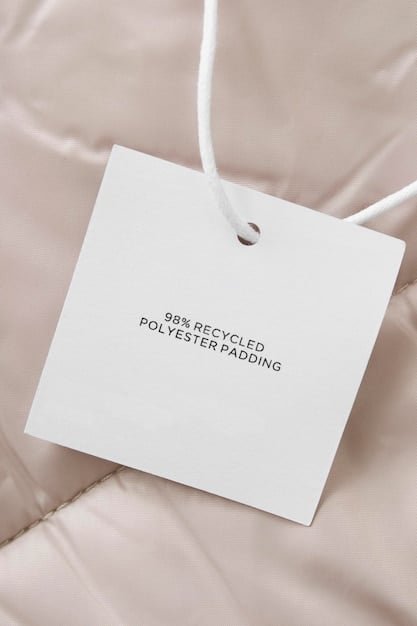Sustainable Shein: Unveiling Eco Initiatives in the US

Sustainable Shein is exploring various eco-conscious initiatives in the US, including responsible sourcing and waste reduction, to address environmental concerns while catering to consumer demand for affordable fashion.
Is sustainable Shein a myth or a developing reality? Let’s delve into the eco-conscious initiatives that Shein is undertaking in the US, examining how they balance affordability with environmental responsibility.
Understanding Shein’s Approach to Sustainability
Shein, a global fashion giant, has faced criticism for its environmental impact. To address these concerns, the brand has launched several initiatives aimed at promoting more sustainable practices in the US market. Understanding these approaches is crucial to assessing Shein’s commitment to eco-consciousness.
The company’s sustainability strategy focuses on various aspects, from material sourcing to waste reduction. While challenges remain, Shein’s efforts represent a step towards aligning with environmental standards.
Responsible Material Sourcing
One key area is the sourcing of materials. Shein has committed to using more recycled and sustainable fabrics in its clothing lines. This includes incorporating recycled polyester, organic cotton, and other eco-friendly materials.
By prioritizing responsible sourcing, Shein aims to reduce its reliance on virgin resources and minimize the environmental footprint of its products.
- Using recycled polyester from plastic bottles reduces waste and lowers carbon emissions.
- Organic cotton farming avoids pesticides and synthetic fertilizers, promoting soil health.
- Innovative fabrics like Tencel offer sustainable alternatives with lower environmental impact.
- Shein’s commitment to transparency in its supply chain is vital for ensuring responsible sourcing practices.
Ultimately, Shein’s approach to sustainability involves a combination of strategies designed to mitigate its environmental impact. While criticisms persist, the company’s actions reflect a growing awareness and effort to address sustainability challenges.
Shein’s Waste Reduction Initiatives in the US
Waste reduction is another critical component of Shein’s sustainable practices in the US. The fast-fashion industry is notorious for generating substantial waste, but Shein is exploring ways to minimize its contribution to this problem.
These initiatives range from optimizing production processes to promoting recycling and reuse among consumers.

Optimizing Production Processes
Shein is leveraging technology and data analytics to optimize its production processes and reduce waste. By closely monitoring demand and adjusting production accordingly, the company aims to minimize overproduction and excess inventory.
This approach involves using real-time data to predict fashion trends and tailor production volumes to meet actual consumer demand.
Promoting Recycling and Reuse
In addition to optimizing its own operations, Shein is also working to promote recycling and reuse among its customers. The company has launched campaigns to encourage consumers to donate or recycle unwanted clothing.
By fostering a culture of recycling and reuse, Shein hopes to extend the lifespan of its products and reduce the amount of clothing that ends up in landfills.
- Providing recycling guidelines and resources on their website.
- Partnering with local recycling centers to facilitate clothing donations.
- Offering incentives for customers who participate in recycling programs.
- Promoting creative ways to upcycle old clothing items.
Waste reduction initiatives are essential for mitigating the environmental impact of the fashion industry. By optimizing production processes and promoting recycling and reuse, Shein is taking steps to reduce waste and promote a more circular economy.
The Role of Technology in Shein’s Eco-Conscious Efforts
Technology plays a pivotal role in enhancing Shein’s sustainable endeavors, offering innovative solutions to address environmental challenges. From streamlining supply chains to enhancing material traceability, tech-driven strategies are at the forefront of Shein’s eco-conscious initiatives.
Let’s explore how technology is being harnessed to revolutionize sustainability within Shein’s operations.
Leveraging AI for Predictive Analytics
Artificial intelligence (AI) stands as a cornerstone in forecasting fashion trends and streamlining production cycles. Shein leverages AI algorithms to analyze consumer preferences, anticipate demand, and fine-tune manufacturing processes.
By reducing overproduction, AI contributes significantly to minimizing waste and optimizing resource allocation.
Blockchain for Supply Chain Transparency
Blockchain technology enhances the transparency and traceability of Shein’s supply chain. By tracking the journey of raw materials from origin to finished product, blockchain ensures responsible sourcing and ethical production practices.
This technology empowers consumers to make informed purchasing decisions, knowing the origins and impact of their clothing.
- Enhancing material traceability from suppliers to consumers.
- Ensuring compliance with environmental and labor standards.
- Fostering trust and accountability within the supply chain.
- Facilitating data-driven decision-making for sustainability improvements.
In conclusion, integrating technology serves as a driving force propelling Shein’s commitment toward sustainable fashion. From AI-powered predictive analytics to blockchain-enabled supply chain transparency, technology emerges as an indispensable asset in reducing environmental impact and fostering ethical practices in the US and beyond.
Challenges and Criticisms of Shein’s Sustainability Claims
Despite Shein’s efforts, the brand’s sustainability claims have faced challenges and criticisms. Skeptics argue that the company’s fast-fashion model inherently contradicts the principles of sustainability. It’s crucial to address these concerns to provide a balanced perspective.
These criticisms often revolve around transparency, greenwashing, and the overall impact of the fast-fashion business model.

Transparency Concerns
One of the main criticisms is the lack of transparency in Shein’s supply chain. Critics argue that it is difficult to verify the company’s claims about responsible sourcing and ethical labor practices. Greater transparency is needed to build trust and ensure accountability.
Without detailed information about its suppliers and manufacturing processes, it is challenging to assess the true impact of Shein’s operations.
Accusations of Greenwashing
Another concern is the potential for greenwashing, where a company exaggerates or misleads consumers about its environmental efforts. Critics argue that Shein’s marketing may overstate the impact of its sustainability initiatives.
Verifying the authenticity and effectiveness of these initiatives requires independent audits and certifications.
- Comparing Shein’s claims against industry benchmarks and standards.
- Seeking independent certifications for its sustainable materials and practices.
- Monitoring the company’s progress towards its sustainability goals.
- Holding Shein accountable for its environmental commitments.
Addressing these challenges and criticisms is essential for improving the credibility and effectiveness of Shein’s sustainability efforts. By increasing transparency, avoiding greenwashing, and addressing the systemic issues of fast-fashion, Shein can make a more meaningful contribution to environmental sustainability.
Consumer Perceptions and the Demand for Sustainable Fashion
Consumer perceptions profoundly impact the demand for sustainable fashion. As awareness of environmental and social issues grows, consumers are becoming more discerning about the brands they support. This shift in consumer behavior influences companies like Shein to adapt and innovate.
The increasing demand for sustainable options necessitates brands to reassess their practices and offer eco-friendly alternatives to meet consumer expectations.
Growing Awareness of Environmental Issues
Consumers are increasingly aware of the environmental consequences of fast fashion, including pollution, waste, and resource depletion. This awareness drives a demand for more sustainable choices.
Social media campaigns, documentaries, and educational initiatives play a key role in raising awareness and influencing consumer attitudes.
The Influence of Social Media and Activism
Social media platforms have become powerful tools for spreading awareness and mobilizing consumer action. Activists and influencers use social media to highlight the environmental and social issues associated with fast fashion.
This increased visibility puts pressure on brands to respond to consumer demands and adopt more sustainable practices.
- Exploring sustainable fashion options and brands.
- Demanding greater transparency from fashion retailers.
- Supporting ethical labor practices and fair wages.
- Reducing consumption and embracing minimalist lifestyles.
Overall, consumer perceptions and the growing demand for sustainable fashion are driving significant changes in the industry. By understanding consumer preferences and adapting to meet their needs, companies like Shein can contribute to a more environmentally responsible future.
Future Prospects: Can Shein Truly Become Sustainable?
As Shein navigates the complexities of the fashion industry, the question remains: can Shein truly become sustainable? The brand’s future prospects depend on its ability to address systemic challenges and demonstrate a genuine commitment to environmental and social responsibility.
Long-term sustainability requires continuous improvement, innovation, and collaboration with stakeholders throughout the supply chain.
Technological Innovations
Continued investment in technological innovations will be crucial for Shein to achieve its sustainability goals. Advanced technologies can optimize production processes, improve material traceability, and reduce waste.
These innovations also include the development of new sustainable materials and recycling technologies.
Collaborations and Partnerships
Collaborating with other organizations, including environmental groups, industry associations, and academic institutions, can enhance Shein’s sustainability efforts. Partnerships can provide access to expertise, resources, and best practices.
These collaborations foster innovation and promote a more holistic approach to sustainability.
- Investing in sustainable materials and production techniques.
- Building transparent and ethical supply chains.
- Engaging with consumers and stakeholders to drive change.
- Setting ambitious sustainability targets and reporting on progress.
Ultimately, the future prospects of Shein becoming truly sustainable depend on a multifaceted approach that encompasses technological innovation, collaboration, and a genuine commitment to environmental and social responsibility. By taking these steps, Shein can work towards a more sustainable and equitable future for the fashion industry.
| Key Aspect | Brief Description |
|---|---|
| ♻️ Recycled Materials | Shein uses recycled polyester and other eco-friendly materials in its clothing lines. |
| 📉 Waste Reduction | Initiatives to minimize overproduction and promote recycling among consumers. |
| 🔗 Supply Chain | Improving transparency in the supply chain through blockchain technology. |
| 🌱 Consumer Demand | Responding to the growing consumer demand for sustainable fashion options. |
FAQ
▼
Shein incorporates recycled polyester, organic cotton, and innovative fabrics like Tencel into its clothing lines, aiming to reduce its environmental impact.
▼
Shein leverages AI and data analytics to optimize production, minimizing overproduction and excess inventory, thus reducing waste generation.
▼
Shein is exploring blockchain technology to track raw materials from origin to product, enhancing transparency and ethical sourcing.
▼
Shein encourages recycling through providing guidelines, partnering with recycling centers, and offering incentives for customers who participate in recycling programs.
▼
Shein faces criticisms over transparency, potential greenwashing, and whether its fast-fashion model can truly align with sustainability principles.
Conclusion
In conclusion, while Shein has launched several eco-conscious initiatives in the US, the path to true sustainability is complex and ongoing. By focusing on responsible sourcing, waste reduction, and technological innovations, while addressing transparency concerns and criticisms, Shein can work towards becoming a more environmentally responsible player in the fashion industry.





